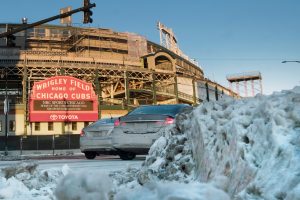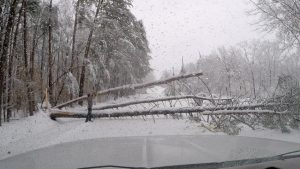
(Reuters) – The blast of Arctic air that brought record-breaking cold, causing at least a dozen deaths and canceling or delaying thousands of flights in the U.S. Midwest, spread eastward on Thursday, bringing frigid misery to the Northeast.
A forecast for warmer weather by the weekend offered little comfort to those enduring icy conditions, brutal winds and temperatures as low as minus 30 degrees Fahrenheit (minus 34 Celsius).
“This morning is some of the coldest of the temperatures across the Upper Midwest, and we still have some dangerous wind chills,” Andrew Orrison, a forecaster for the National Weather Service, said in a phone interview.
In Minnesota and Upper Michigan, temperatures will be at minus 20F (minus 29C) on Thursday and parts of North Dakota can expect minus 30F, forecasters warned.
The bitter cold was caused by displacement of the polar vortex, a stream of air that normally spins around the stratosphere over the North Pole but whose current was disrupted. It pushed eastward and states including Massachusetts, New York and Pennsylvania experienced bitterly cold temperatures. The overnight low in Boston was at minus 5F (minus 21C), according to the National Weather Service.
“This morning is the worst of the worst in terms of the cold,” Orrison said. “It’ll be the coldest outbreak of Arctic air (so far this winter) for the Mid-Atlantic and the Northeast.”

Desolate Wrigley Field is seen at sunset during subzero temperatures carried by the polar vortex, in Chicago, Illinois, U.S., January 30, 2019. REUTERS/Pinar Istek
It has been more than 20 years since a similar Arctic blast covered a swath of the Midwest and Northeast, according to the weather service.
The cold has caused at least 12 deaths since Saturday across the Midwest, according to officials and news media reports. Some died in weather-related traffic accidents, others from apparent exposure to the elements.
Videos this week showed boiling water freezing as it was tossed in the air in Cedar Rapids, Iowa, and transit workers in Chicago setting fire to train tracks to keep them from locking up.
Even parts of the South, such as the mountains of Kentucky, Tennessee and upper Georgia, will be in the single digits, the weather service said.
More than 30 record lows were shattered across the Midwest. Some areas only saw a high of minus 10F (minus 23F) on Wednesday.
The lowest temperature recorded that day was minus 40F (minus 40C) in International Falls, Minnesota, just south of Canada. The city, dubbed the “Icebox of the Nation,” saw temperatures drop another 5 degrees F early on Thursday.
U.S. homes and businesses used record amounts of natural gas for heating on Wednesday, according to preliminary results from financial data provider Refinitiv.
But the picture was set to change. By the weekend, Chicago, which experienced near-record cold of minus 23F (minus 30C) on Wednesday and minus 21F (minus 29C) on Thursday, was expected to bask in snow-melting highs in the mid-40s to low 50s Fahrenheit. So will other parts of the Midwest.
“It’s going to feel quite balmy in comparison,” Orrison said.
The weather caused hundreds of traffic accidents, including a chain-reaction collision of about two dozen cars in Grand Rapids, Michigan, during a whiteout on Wednesday, local media reported.
More than 2,500 flights were canceled and more than 3,500 were delayed on Thursday morning, most of them out of Chicago’s O’Hare International and Midway International airports, according to the flight tracking site FlightAware.com.
General Motors Co suspended operations at 11 Michigan plants and it’s Warren Tech Center after a utility made an emergency appeal to users to conserve natural gas after extreme cold and a fire at a compressor station. Fiat Chrysler Automobiles NV also canceled a shift on Thursday at two of its plants.
(Reporting by Rich McKay in Atlanta; Additional reporting by Suzannah Gonzales and Karen Pierog in Chicago, Gina Cherelus in New York, and Alex Dobuzinskis and Dan Whitcomb in Los Angeles; Editing by Larry King, Bill Trott and Jonathan Oatis)









